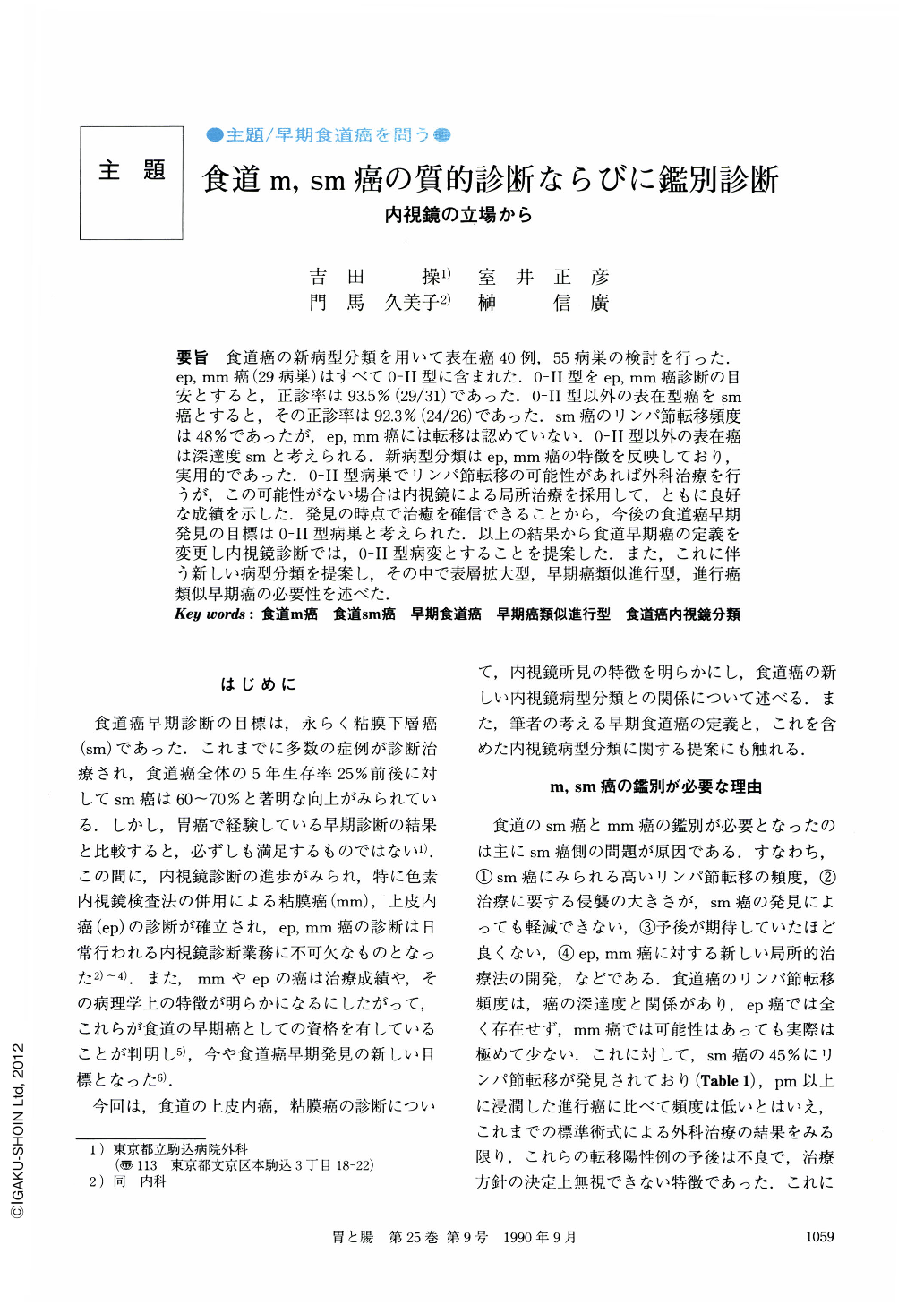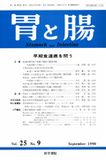Japanese
English
- 有料閲覧
- Abstract 文献概要
- 1ページ目 Look Inside
- サイト内被引用 Cited by
要旨 食道癌の新病型分類を用いて表在癌40例,55病巣の検討を行った.
ep,mm癌(29病巣)はすべて0-Ⅱ型に含まれた.0-Ⅱ型をep,mm癌診断の目安とすると,正診率は93.5%(29/31)であった.0-Ⅱ型以外の表在型癌をsm癌とすると,その正診率は92.3%(24/26)であった.sm癌のリンパ節転移頻度は48%であったが,ep,mm癌には転移は認めていない.0-Ⅱ型以外の表在癌は深達度smと考えられる.新病型分類はep,mm癌の特徴を反映しており,実用的であった.0-Ⅱ型病巣でリンパ節転移の可能性があれば外科治療を行うが,この可能性がない場合は内視鏡による局所治療を採用して,ともに良好な成績を示した.発見の時点で治癒を確信できることから,今後の食道癌早期発見の目標は0-Ⅱ型病巣と考えられた.以上の結果から食道早期癌の定義を変更し内視鏡診断では,0-Ⅱ型病変とすることを提案した.また,これに伴う新しい病型分類を提案し,その中で表層拡大型,早期癌類似進行型,進行癌類似早期癌の必要性を述べた.
Superficial cancer which used to be defined as cancer remaining within the submucosa (sm) was an early indication of esophageal cancer. Studies made on 26 cases with submucosal cancer of the esophagus revealed that there were frequent lymph node metastases (48%) and recurrence. 64% of such cases had a five year survival rate. On the other hand, lymph node metastasis was rare in intraepithelial cancer (ep) (0%) and in mucosal cancer (mm) (0%) and their prognosis was excellent (100%). Recently, a new endoscopic classification of esophageal cancer was proposed by the Japanese Society for Esophageal Diseases.
The new classification recognizes 5 types;-
(1) Type 0―Superficial type
0-Ⅰ―Superficial and protruding type
0-Ⅱ―Superficial flat type
0-Ⅱa―Superficial flat and slightly elevated type
0-Ⅱb―Superficial flat type
0-Ⅱc―Superficial flat and slightly depressed type
0-Ⅲ―Superficial and excavated type
(2) Type 1, 2, 3 and 4―Advanced type
(3) Type 5―Miscellaneous type
Clinical application of this classification for 40 of our superficial cancer cases allowed us to diagnose 0-Ⅱ type lesions as (ep) or (mm) cancer with an accuracy rate of 93.5%, and 0-Ⅰ or 0-Ⅲ lesions other than 0-Ⅱ type as (sm) cancer with an accuracy rate of 92.3%. Excellent prognosis of 0-Ⅱ lesions following conventional esophagectomy suggests that 0-Ⅱ leson is really “early esophageal cancer”. Results of this study suggest that (ep) and (mm) cancer of the esophagus can be identified as 0-Ⅱ type lesions by endoscopy, and they rarely have lymph node metastasis. Hence, 0-Ⅱ type lesions should be considered as early cancer of the esophagus. However, clinically speaking, 1) 0-Ⅰ lesions of submucosal cancer should be regarded as advanced cancer type Ⅰ, and, 0-Ⅲ lesion should be regarded as type-2 or 3 advanced cancer, 2) submucosal cancer that resembles mucosal cancer should be called “early cancer-like-advanced type”, 3) an early cancer that looks like an advanced cancer should be called “advanced cancer-like-early type”.

Copyright © 1990, Igaku-Shoin Ltd. All rights reserved.


